
Over the past two months, the calls to wind-back negative gearing have grown louder, spearheaded by Fairfax media.
In early March, Fairfax’s Michael McNamara wrote a fantastic article arguing to abolish negative gearing. This article was followed up in Fairfax by Saul Eslake, who lambasted Australia’s dysfunctional tax system, especially negative gearing, for the way in which it encourages borrowing and speculating, and penalises working and saving.
Then last week, Fairfax published an article noting that the Gillard Government is considering curbing negative gearing for multiple investment property holdings.
And on Monday, Saul Eslake followed up last month’s piece with another fantastic article in Fairfax once again attacking Australia’s tax system for encouraging borrowing and speculating, and penalising working and saving. Mr Eslake’s article covers a number of aspects relating to Australia’s tax system, and I encourage you to read it for yourself. I have reproduced the sections pertaining to negative gearing below, together with some charts for additional context.
Very few other ”advanced” economies are as generous in their tax treatment of geared investments as Australia is.
In the United States, for example, investors can only deduct interest incurred on borrowings undertaken to buy property or shares up to the amount of income (dividends or rent) earned in any given financial year; any excess of interest expense over income (as in a negatively geared investment) must be ”carried forward” as a deduction against the capital gains tax payable when the asset is eventually sold.
In Australia, by contrast, where interest on borrowings undertaken to finance the purchase of a property or shares exceeds the rent or dividend income generated by those investments, that excess can be deducted against a taxpayer’s other income (such as wages and salaries) thereby reducing the amount of tax otherwise payable on that other income.
The Howard government’s 1999 decision to tax capital gains at half the rate applicable to wage and salary income, converted negative gearing from a vehicle allowing taxpayers to defer tax on their wage and salary income (until they sold the property or shares that they had purchased with borrowed money), into one allowing taxpayers to reduce their taxation obligations (by, in effect, converting wage and salary income into capital gains taxed at half the normal rate) as well as deferring them.
As a result, negative gearing has become much more widespread over the past decade, and much more costly in terms of forgone revenue.
In 1998-99, when capital gains were last taxed at the same rate as other types of income (less an allowance for inflation), Australia had 1.3 million taxpaying landlords who in total made a taxable profit of almost $700 million. By 2008-09, the latest year for which statistics are available, the number of taxpaying landlords had risen to just under 1.7 million: but they collectively lost $6.5 billion, largely because the amount they paid out in interest rose almost fourfold (from just over $5 billion to almost $20 billion over this period), while the amount they collected in rent ”only” slightly more than doubled (from $11 billion to $26 billion), as did other (non-interest) expenses.
The data Mr Eslake is referring to is provided in the below charts, which have been derived from the Australian Taxation Office (ATO) Taxation Statistics.
First, consider the number of property investors reporting to the ATO over the years 1999-00 and 2008-09:
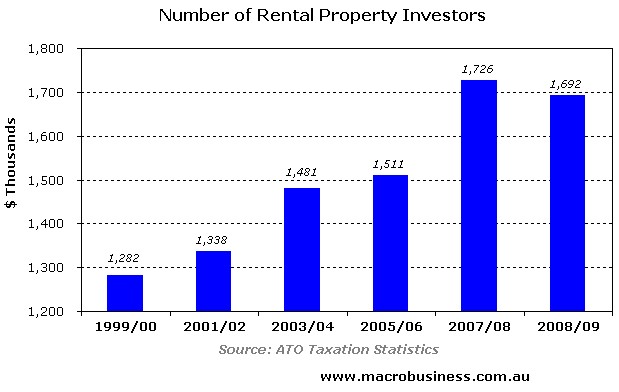
Second, consider the overall value of net rental losses over the years 1999-00 and 2008-09:
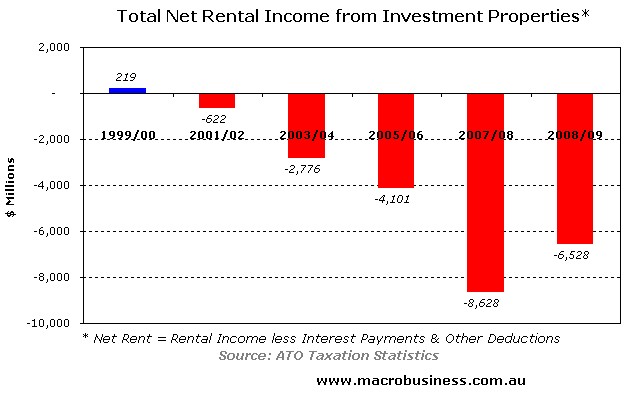
Anyway, back to Mr Eslake’s article.
If all the 1.1 million landlords who in total reported net losses in 2008-09 were in the 38 per cent income tax bracket, their ability to offset those losses against their other taxable income would have cost more than $4.3 billion in revenue forgone. If, say, a fifth of them had been in the top tax bracket then the cost to revenue would have topped $4.6 billion.
(The revenue forgone through negative gearing was lower in 2008-09 than it was in 2007-08, because the number of taxpayers reporting rental income fell by about 51,000 (presumably as a result of the global financial crisis prompting some landlords to sell their properties), and because the substantial decline in interest rates after the onset of the financial crisis meant that fewer landlords paid more in interest than they received in net rent.
A breakdown of investment property holdings by income group is provided below. This chart shows that 78% of all investment properties in 2008-09 were held by individuals earning less than $80,000 per annum. In addition, 66% of investment properties were negatively geared.
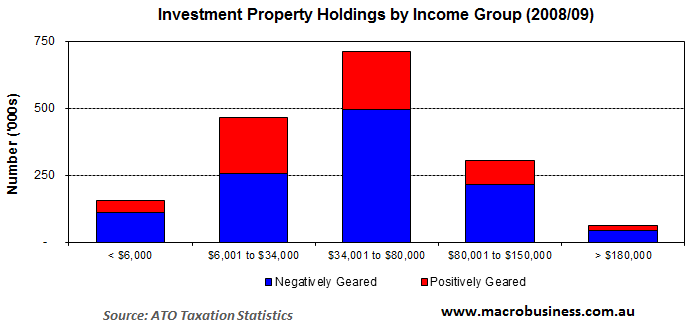
Back to Mr Eslake’s article.
The figures in the previous paragraph also exclude revenue forgone through negatively gearing of share portfolios or other investments, on which no details are available.
This is a pretty large subsidy from people who are working and saving to people who are borrowing and speculating (since those landlords who are making ”running losses” on their property investments expect to more than make up those losses through capital gains when they sell the properties.
And it’s hard to think of any worthwhile public policy purpose that is served by it. It certainly does nothing to increase the supply of housing, since the vast majority of landlords buy established properties: 92 per cent of all borrowing by residential property investors over the past decade has been for the purchase of established dwellings, as against 82 per cent of all borrowing by owner-occupiers.
The below charts confirm Mr Eslake’s findings that investors are overwhelmingly choosing to invest in existing dwellings, thereby, they are not adding to rental availability or affordability. First, consider the percentage of investor mortgages going to existing dwellings versus new construction.
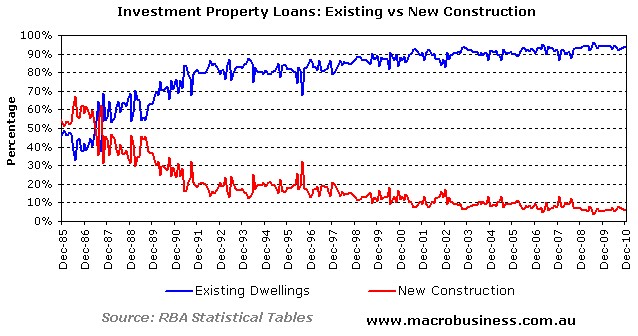
As you can see, the share of investment in new construction has fallen for the past 25 years, from around 60% in the mid-1980s to 6% currently. So despite the favourable tax treatment provided to property investors in Australia, for every 17 investment homes purchased in December 2010, only one was a new dwelling that actually added to housing supply and rental availability.
Second, as shown below, investor loans for new construction have remained relatively flat for the past 25 years whereas loans for second-hand properties surged from around 2000 onwards, coincident with the reduction in Capital Gains Tax.
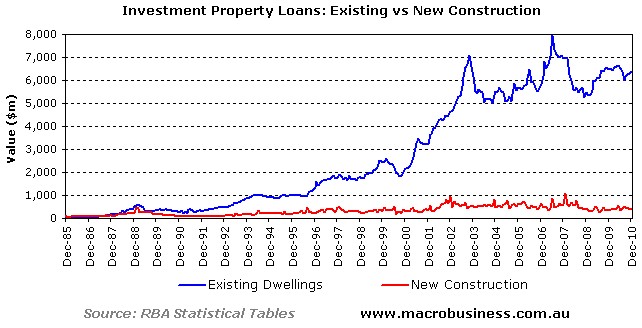
As a comparison, the ratio of investor lending for existing dwellings to new dwellings was around 2:3 in 1985; 7:1 in 2000; and 16:1 currently.
Again, back to Mr Eslake’s article.
Precisely for that reason, the availability of negative gearing contributes to upward pressure on the prices of established dwellings, and thus diminishes housing affordability for would-be home buyers.
Supporters of negative gearing argue that its abolition would lead to a ”landlords’ strike”, driving up rents and exacerbating the existing shortage of affordable rental housing. They point to ”what happened” when the Hawke government abolished negative gearing (only for property investment) in 1986, claiming it led to a surge in rents, which prompted the reintroduction of negative gearing in 1988.
This assertion has attained the status of urban myth. However, it is not true. If the abolition of negative gearing had led to a landlords’ strike, as proponents of negative gearing usually assert, then rents should have risen everywhere (since negative gearing had been available everywhere). In fact, rents (as measured in the consumer price index) actually only rose rapidly (at double-digit rates) in Sydney and Perth. And that was because in those two cities rental vacancy rates were unusually low (in Sydney’s case, barely above 1 per cent) before negative gearing was abolished. In other capitals (where vacancy rates were higher), growth in rentals was either unchanged or, in Melbourne, actually slowed.
The below chart once again supports Mr Eslake’s findings. It shows real (inflation-adjusted) rents for the Australian mainland capital cities. The first vertical dotted black line shows the beginning of the ‘ban’ on negative gearing (July 1985), whereas the second vertical dotted black line shows its reintroduction in September 1987.
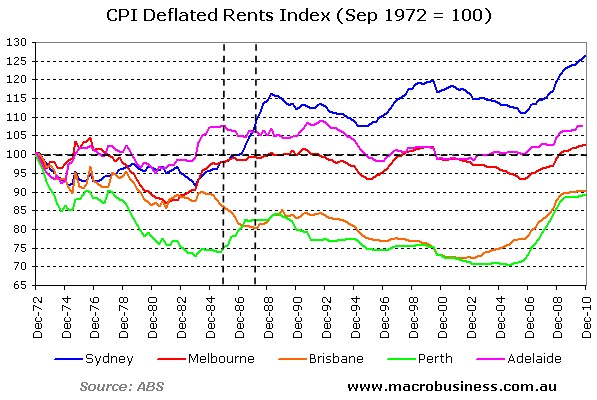
According to the ABS, between July 1985 and September 1987, rents rose in both Sydney and Perth but were either flat or falling in the other major capitals.
Back to Mr Eslake’s article.
Notwithstanding this history, suppose that a large number of landlords were to respond to the abolition of negative gearing by selling their properties. That would push down the prices of investment properties, making them more affordable to would-be home buyers, allowing more of them to become home owners, and thereby reducing demand for rental properties in almost exactly the same proportion as the reduction in the supply of them.
It’s actually quite difficult to think of anything that would do more to improve affordability conditions for would-be home buyers than the abolition of negative gearing. It would certainly do more than continuing to give large amounts of cash to would-be first-time home buyers through grants or stamp duty concessions, which historically have served only to increase the prices of existing dwellings and ended up in the pockets of vendors.
There’s absolutely no evidence to support the assertion made by proponents of the continued existence of negative gearing that it results in more rental housing being available than would be the case were it to be abolished (even though the Henry review appears to have swallowed this assertion).
Most other advanced economies don’t have negative gearing: yet most other countries have higher rental vacancy rates than Australia does. In the US, which doesn’t allow negative gearing, the rental vacancy rate has in the past 50 years only once been below 5 per cent (and that was in the March quarter of 1979); in the 10 years before the onset of the most recent recession, it has averaged 9.1 per cent. Yet here in Australia, which does allow negative gearing, the rental vacancy rate has never (at least in the past 30 years) been above 5 per cent, and in the period since negative gearing became more attractive (as a result of the halving of the capital gains tax rate) it has fallen from more than 3 per cent to less than 2 per cent. During that period, rents rose at a rate of 0.8 percentage points a year faster than the CPI as a whole, whereas over the preceding decade, rents rose at the same rate as the CPI.
I’m not advocating that negative gearing be abolished for property investments only, as happened between 1986 and 1988. That would be unfair to property investors. I think negative gearing should be abolished for all investors, so that interest expenses would only be deductible in any given year up to the amount of investment income earned in that year, with any excess carried forward against the ultimate capital gains tax liability, rather than being used to reduce the tax payable on wage and salary or other income (as is the case in the US and most other ”advanced” economies).
But I’d settle for the recommendation of the Henry review, which was that only 40 per cent of interest (and other expenses) associated with investments be allowed as a deduction, and that capital gains (and other forms of investment income, including interest on deposits) be taxed at 60 per cent (rather than 50 per cent now) of the rates applicable to the same amounts of wage and salary income.
This recommendation would not amount to the abolition of negative gearing – it would just make it less generous. It would be likely, as the Henry review suggested, ”to change investor demand towards housing with higher rental yields and longer investment horizons [and] may result in a more stable housing market, as the current incentive for investors to chase large capital gains in housing would be reduced”.
I could even accept the Henry review’s recommendation that ”these reforms should only be adopted following reforms to the supply of housing and reforms to housing assistance” that it makes elsewhere, even though I disagree with the Henry review’s concern that these reforms ”may in the short term reduce residential property investment”.
Sadly, these recommendations were among the 19 that the Treasurer explicitly ruled out when releasing the Henry review in May.
That makes it hard to believe that this government (or indeed any alternative government) is serious about increasing the incentives to work and save – or at least, about doing so without risking the votes of those who borrow and speculate, in effect subsidised by those who don’t, or can’t.
Thanks to the likes of Mr Eslake, the general public is growing increasingly wary of negative gearing as well as other demand-side measures aimed at stimulating the housing market.
With a bit of luck, the Federal Government will eventually sense the change of mood in the electorate and seize the opportunity to reform Australia’s destructive housing policies (including also Australia’s restrictive urban planning system).
At a minimum, the greater public awareness of these issues should make it more politically unpopular for the Government to implement additional housing stimulus.
Cheers Leith

